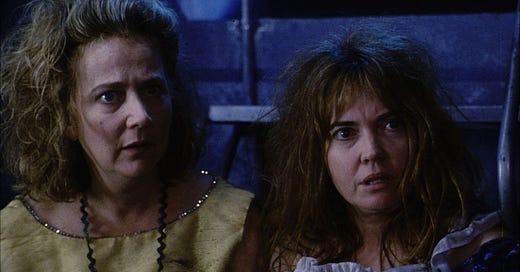Shelf Life Review
Credit: Northwest Film Forum
Shelf Life may be Paul Bartel’s forgotten film. An unreleased, made for theatre, bonkers black-comedy musical and Bartel’s final film before his death in 2000. Matchbox Cineclub resurrects this lost gem, a film very reminiscent of John Paizs Crime Wave that Matchbox screened at the Weird Weekend last year. Much like Paizs, Bartel most definitely follows suit as an unconventional, hyperbolic and a completely mesmerising director.
Bartel’s Shelf Life adopts a similar subversive style to his iconic film Eating Raoul. A film many audiences may be a little more familiar with, a cult classic from the early ‘80s that had a criterion release in 2012. Shelf Life, much like Eating Raoul, observes humanity through madness, chaos and existential instability - in an eccentric package that showcases the comedic extremities in a light-hearted dystopia.
The film begins in 1963, where a suburban family takes refuge in an in-build bomb shelter that exists behind the family bookcase. After the assassination of JFK and the parents’ paranoia of an expected invasion from the “commies”, they move down there to hide until it’s safe. As we move forward thirty years into the future, we see the children grown up and living in the same shelter, but far from adults in any sense. They survive in their own imaginary world, learning snippets from a couple of science and history books that are down there, small bits of television shows that manage to come through the static for a few seconds, and vinyls on the record player. Unfortunately, they neither have the education or the experience to put much, or any of it together.
Bartel’s creation is a must-see, a film that by any sense should not really work at all, but does succeed at numerous creative levels. It’s not quite so surprising that the film never had a theatrical release, it would be a difficult movie to put on the big screen - it looks more similar to a Samuel Beckett play you’d see on the stage than a popcorn flick at the local multiplex. Nevertheless there is a lot of merit to the film, and enough ambiguity to let it linger in memories and conversations to come. The movie itself is based on a play written by the cast members O-Lan Jones, Jim Turner, and Andrea Stein, and it is clear that Bartel has given creative control to the writers. The structure of the film is similar to something you would see at the theatre, there are mad, sporadic monologues that each of the adult-children burst into, helping the audience to zone into their imaginary spaces as well as understand their living situation and circumstances more in depth. Musical numbers crop up during their improvisation games that add charm and sympathy to their infantile states. And much like absurdist plays, the film’s writing resonates through their own language that becomes much more translatable as the plot develops.
What is certainly worthy of applause is how much Shelf Life can truly absorb its viewership into the unreal reality on-screen, especially when you consider the fact that the setting of the film is confined, predominantly, to a single location. One of the many problems that can arise from this essence of continual claustrophobia is that the effect loses itself to repetition and will eventually dull as a result, leaving the audience less anxious about escape, and more comfortably bored. This is not really the case at all for Shelf Life, and it may come down to the busy and psychedelic design of the shelter. It is almost reminiscent of an interactive escape room: a static TV that every now and then finds a brief signal, a bare storage room with few tins of food remaining, and floor-level mattresses hidden behind makeshift blanket-forts. Not only is the layout like something from a kooky ‘90s teen goosebumps style series, but it almost has a sensory quality to it as the characters bring the pieces of the shelter to life with them. Without sounding like something out a Sex In the City episode, the shelter itself seems to be character of its own - inhabiting the potential for death, escape, companionship, and distrust simultaneously.
I don’t know if there’s another film out there that has such a strong connection to childhood, even if it is entirely personified through adults. The women plot against each other through their brother, feigning illness for attention and forgiveness, improvised wacky games like “Egyptian Fantasy”, “Mighty Car”, and “Schooltime” that seem to be based on the clips that come through the television from shows and movies and the small moments they are exposed to. There is a very strong evocation of the deep imagination that exists in a childhood, and the freedom and sensitivity that flows through each game.
Shelf Life is most definitely a hidden gem that experimental film fans will find deeply interesting. While the film won’t in any case be for everyone, it is a film that will resonate with audiences after the credits roll - opinion and perception are almost guaranteed to differ in extremes. Bartel’s film is a very hypnotic experience, those familiar with existential theatre, as well as the films from last year’s Weird Weekend will likely be intrigued. Sadly, it may be a film completely lost in the next couple of decades, so experimental and arthouse enthusiasts like myself are always grateful to Matchbox Cineclub for breathing new life into these fun and flamboyant flicks.
‘Steph’s Words on Cinema’ is a newsletter which focuses on reviewing independent, experimental and art-house films. It is free so please do subscribe and share. I also write for Take One Cinema, Eye For Film and my twitter handle is @stephpbrown_




